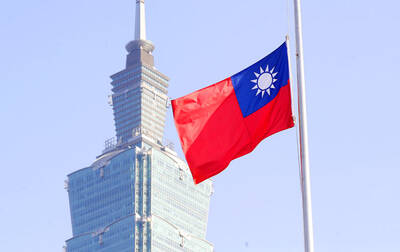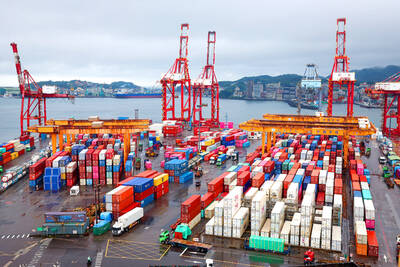Powerchip Semiconductor Corp (力晶半導體), the nation’s largest computer memory chipmaker in terms of revenue, presented an industry consolidation proposal to the Ministry of Economic Affairs (MOEA) yesterday.
Facing imminent bankruptcy, Powerchip and its smaller DRAM rival ProMOS Technologies Inc (茂德科技) have been aggressively seeking a government bailout.
Eric Tang (譚仲民), Powerchip vice president and spokesman, confirmed in a telephone call that the proposal was sent to the ministry yesterday afternoon, but declined to provide any details.
“Powerchip is deferring all comments to the ministry at this point,” he said.
In a filing to the Taiwan Stock Exchange, Powerchip said the proposal involved a three-way collaboration between Powerchip, Rexchip Electronics Corp (瑞晶電子) and Japan’s Elpida Memory Inc, information posted on the exchange’s Web site shows.
Local media speculated yesterday that Powerchip may seek more than NT$20 billion (US$605.6 million) from the government in exchange for a stake in the firm.
Rexchip is a joint venture between Powerchip and Elpida that was established in November 2006.
Hsinchu-based Powerchip held a routine board of directors meeting yesterday to discuss its consolidation proposal. Other items on the agenda included Powerchip’s syndicated loan rollover procedures, adjustments to independent board member compensation as well as next year’s planned auditor expenses and full-year budget, the exchange filing said.
Powerchip applied to the government for a loan rollover last week. The firm has NT$60 billion to NT$70 billion in bank loans, the Wall Street Journal has reported.
Topology Research Institute (拓墣產業研究所) said government aid was crucial to the DRAM industry’s survival.
“So far our government has poured trillions of NT dollars into this industry, not to mention more than NT$500 billion invested by the public and the NT$500 billion taken out in bank loans,” the Taipei-based market researcher said in an e-mail.
Not to help DRAM companies would put more than 20,000 employees and their families at dire financial risk, Topology said.
Topology said DRAM and computer industries were the economic jewels of the nation — to allow either to go under would cause unprecedented economic turmoil.
Meanwhile, Nanya Technology Corp (南亞科技), the country’s No. 2 chipmaker, was still mulling over applying for government aid.
It has not yet sought an extension on its bank loanst, citing only NT$3 billion worth of short-term obligations maturing in the first half of next year, Nanya’s spokesperson Pai Pei-lin (白培霖) said.
Asked if Nanya was putting together its own consolidation proposal, Pai said no, but did not rule out the possibility in the future.

ELECTRONICS BOOST: A predicted surge in exports would likely be driven by ICT products, exports of which have soared 84.7 percent from a year earlier, DBS said DBS Bank Ltd (星展銀行) yesterday raised its GDP growth forecast for Taiwan this year to 4 percent from 3 percent, citing robust demand for artificial intelligence (AI)-related exports and accelerated shipment activity, which are expected to offset potential headwinds from US tariffs. “Our GDP growth forecast for 2025 is revised up to 4 percent from 3 percent to reflect front-loaded exports and strong AI demand,” Singapore-based DBS senior economist Ma Tieying (馬鐵英) said in an online briefing. Taiwan’s second-quarter performance beat expectations, with GDP growth likely surpassing 5 percent, driven by a 34.1 percent year-on-year increase in exports, Ma said, citing government

‘REMARKABLE SHOWING’: The economy likely grew 5 percent in the first half of the year, although it would likely taper off significantly, TIER economist Gordon Sun said The Taiwan Institute of Economic Research (TIER) yesterday raised Taiwan’s GDP growth forecast for this year to 3.02 percent, citing robust export-driven expansion in the first half that is likely to give way to a notable slowdown later in the year as the front-loading of global shipments fades. The revised projection marks an upward adjustment of 0.11 percentage points from April’s estimate, driven by a surge in exports and corporate inventory buildup ahead of possible US tariff hikes, TIER economist Gordon Sun (孫明德) told a news conference in Taipei. Taiwan’s economy likely grew more than 5 percent in the first six months

SMART MANUFACTURING: The company aims to have its production close to the market end, but attracting investment is still a challenge, the firm’s president said Delta Electronics Inc (台達電) yesterday said its long-term global production plan would stay unchanged amid geopolitical and tariff policy uncertainties, citing its diversified global deployment. With operations in Taiwan, Thailand, China, India, Europe and the US, Delta follows a “produce at the market end” strategy and bases its production on customer demand, with major site plans unchanged, Delta president Simon Chang (張訓海) said on the sidelines of a company event yesterday. Thailand would remain Delta’s second headquarters, as stated in its first-quarter earnings conference, with its plant there adopting a full smart manufacturing system, Chang said. Thailand is the firm’s second-largest overseas

SUPPLY RESILIENCE: The extra expense would be worth it, as the US firm is diversifying chip sourcing to avert disruptions similar to the one during the pandemic, the CEO said Advanced Micro Devices Inc (AMD) chief executive officer Lisa Su (蘇姿丰) on Wednesday said that the chips her company gets from supplier Taiwan Semiconductor Manufacturing Co (TSMC, 台積電) would cost more when they are produced in TSMC’s Arizona facilities. Compared with similar parts from factories in Taiwan, the US chips would be “more than 5 percent, but less than 20 percent” in terms of higher costs, she said at an artificial intelligence (AI) event in Washington. AMD expects its first chips from TSMC’s Arizona facilities by the end of the year, Su said. The extra expense is worth it, because the company is